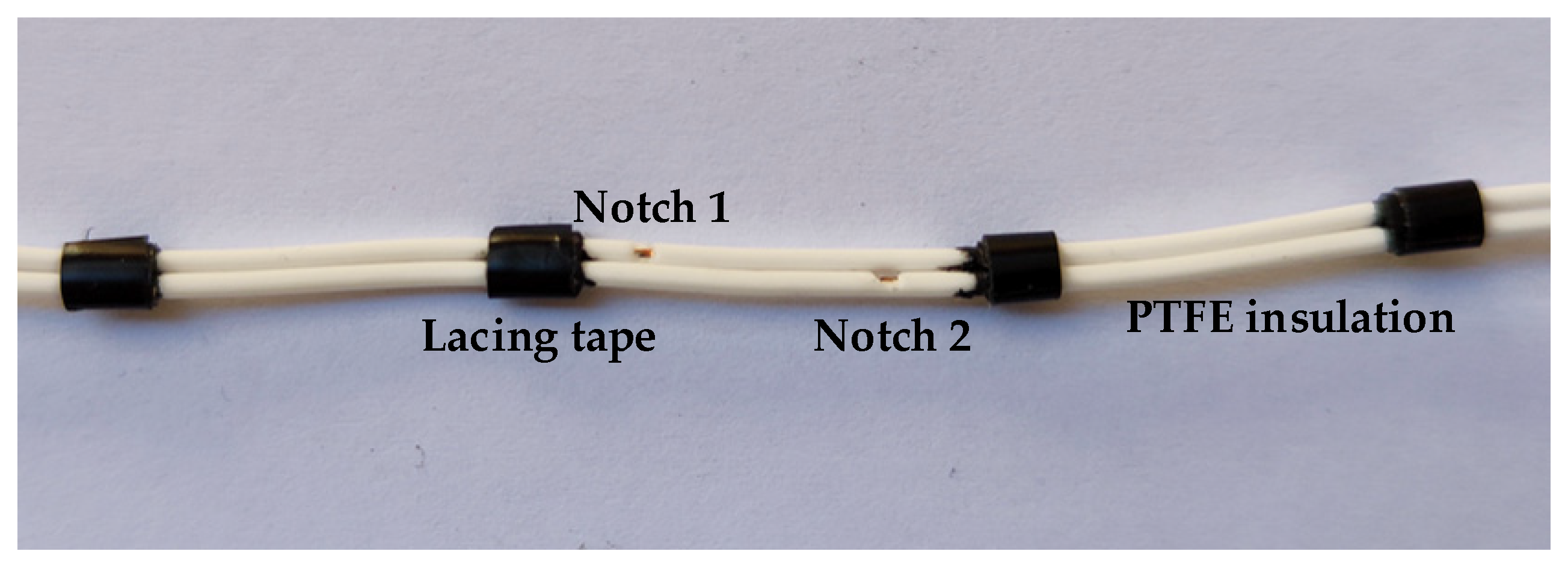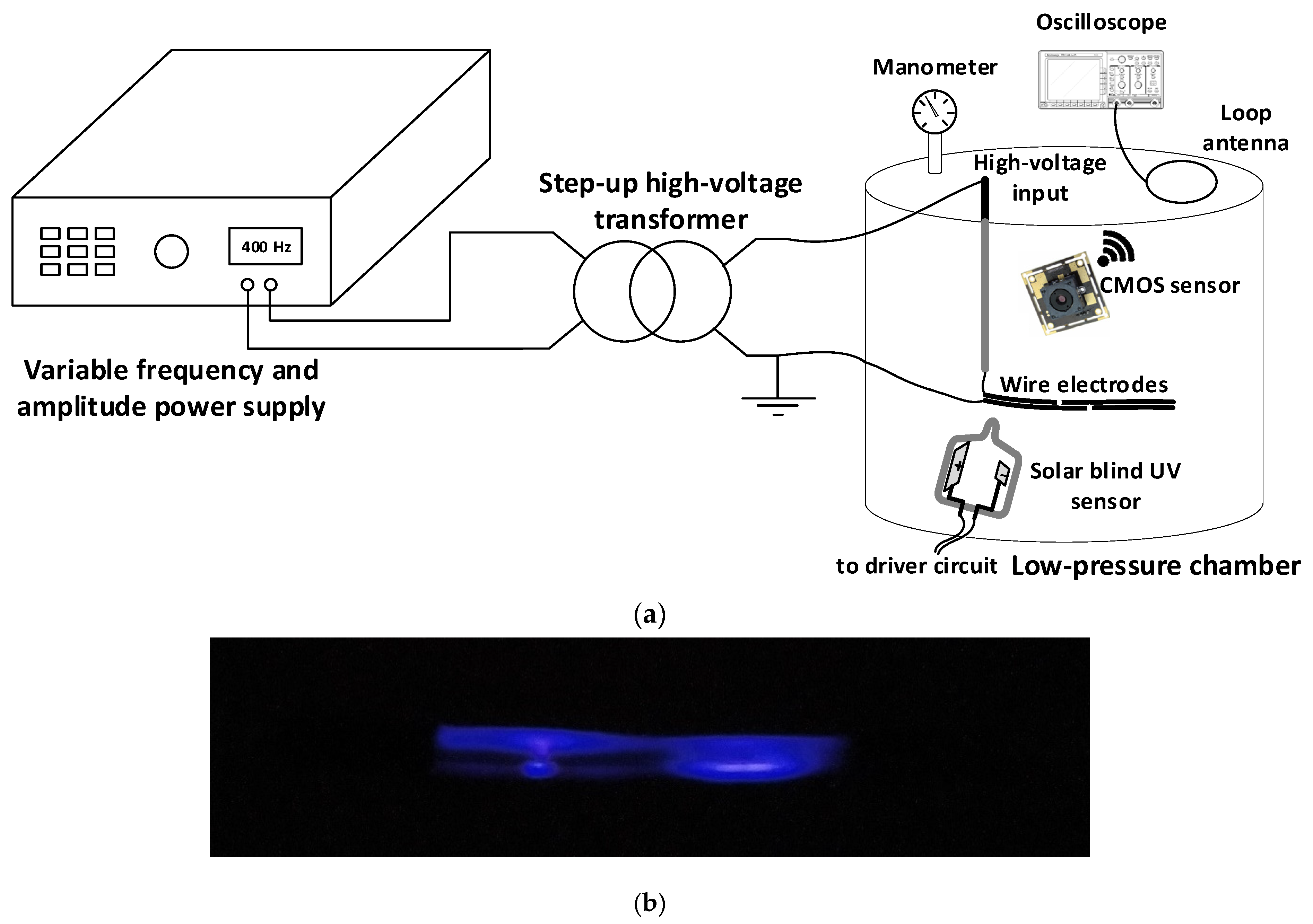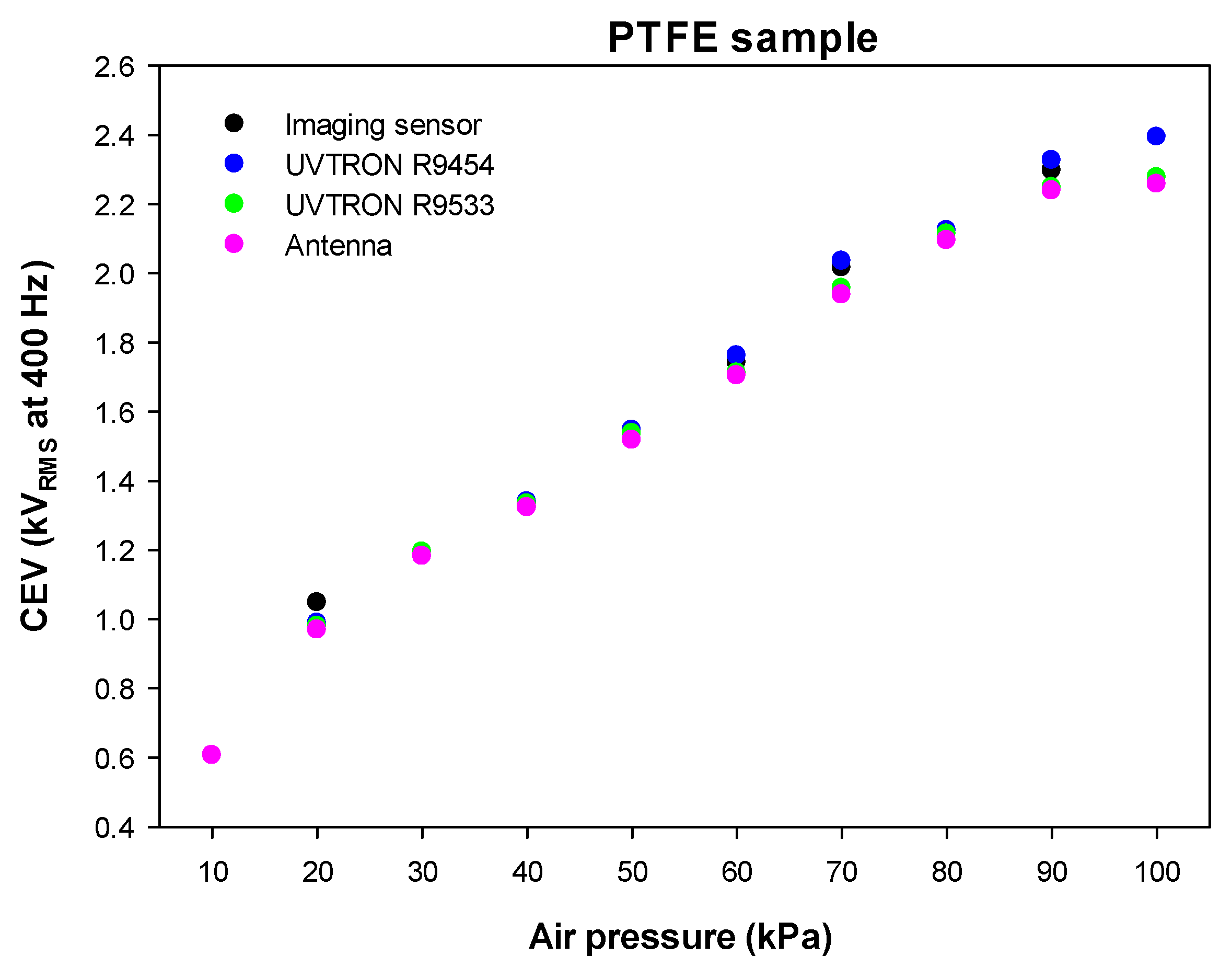Performance Evaluation of Solar-Blind Gas-Filled Sensors to Detect Electrical Discharges for Low-Pressure Aircraft Applications
Abstract
:1. Introduction
2. Experimental Setup
2.1. The Analyzed Sensors
2.2. The Wire Electrodes
2.3. The Low-Pressure Chamber
2.4. The Programmable High-Voltage Source
2.5. The Corona Extinction Voltage (CEV) Value
3. Experimental Results
3.1. Initial Experimental Tests with the Solar-Blind Sensors
3.2. Experimental Tests with the Wire Electrodes Inside the Low-Pressure Chamber
4. Conclusions
Author Contributions
Funding
Institutional Review Board Statement
Informed Consent Statement
Data Availability Statement
Acknowledgments
Conflicts of Interest
References
- Riba, J.-R.; Gomez-Pau, A.; Moreno-Eguilaz, M. Sensor Comparison for Corona Discharge Detection Under Low Pressure Conditions. IEEE Sens. J. 2020, 20, 11698–11706. [Google Scholar] [CrossRef]
- Riba, J.-R.; Gómez-Pau, Á.; Moreno-Eguilaz, M. Experimental Study of Visual Corona under Aeronautic Pressure Conditions Using Low-Cost Imaging Sensors. Sensors 2020, 20, 411. [Google Scholar] [CrossRef] [PubMed] [Green Version]
- Kuffel, J.; Zaengl, W.S.; Kuffel, P. High Voltage Engineering Fundamentals, 2nd ed.; Newnes: Oxford, UK, 2000; ISBN 978-0-7506-3634-6. [Google Scholar]
- CleanSky. 9th Call for Proposals (CFP09)—List and Full Description of Topics; CleanSky: Brussels, Belgium, 2018; pp. 1–354. [Google Scholar]
- Esfahani, A.N.; Shahabi, S.; Stone, G.; Kordi, B. Investigation of Corona Partial Discharge Characteristics Under Variable Frequency and Air Pressure. In Proceedings of the 2018 IEEE Electrical Insulation Conference (EIC), San Antonio, TX, USA, 17–20 June 2018; pp. 31–34. [Google Scholar]
- Capineri, L.; Dainelli, G.; Materassi, M.; Dunn, B.D. Partial discharge testing of solder fillets on PCBs in a partial vacuum: New experimental results. IEEE Trans. Electron. Packag. Manuf. 2003, 26, 294–304. [Google Scholar] [CrossRef]
- Karady, G.G.; Sirkis, M.D.; Li, L. Investigation of corona initiation voltage at reduced pressures. IEEE Trans. Aerosp. Electron. Syst. 1994, 30, 144–150. [Google Scholar] [CrossRef]
- Landfried, R.; Savi, L.; Leblanc, T.; Teste, P. Parametric study of electric arcs in aeronautical condition of pressure. EPJ Appl. Phys. 2014, 67, 20802. [Google Scholar] [CrossRef]
- Hongkun, Z.; Tao, C.; Wenjun, L. Arc fault signatures detection on aircraft wiring system. In Proceedings of the World Congress on Intelligent Control and Automation (WCICA), Dalian, China, 21–23 June 2006; Volume 2, pp. 5548–5552. [Google Scholar]
- Dornheim, M.A. New rules and hardware for wiring soon to emerge. Aviat. Week Space Technol. 2001, 154, 92. [Google Scholar]
- Furse, C.; Safavi, M.; Smith, P.; Lo, C. Feasibility of spread spectrum sensors for location of arcs on live wires. IEEE Sens. J. 2005, 5, 1445–1449. [Google Scholar] [CrossRef]
- Lectromec. 2016 Statistical Analysis of EWIS Failures of the US Commercial Aircraft Fleet and How to Improve; Lectromec: Chantilly, VA, USA, 2017. [Google Scholar]
- Yuan, Z.; Ye, Q.; Wang, Y.; Guo, Z. State Recognition of Surface Discharges by Visible Images and Machine Learning. IEEE Trans. Instrum. Meas. 2020, 70, 5004511. [Google Scholar] [CrossRef]
- Hernández-Guiteras, J.; Riba, J.-R.; Romeral, L. Redesign process of a 765kVRMS AC substation connector by means of 3D-FEM simulations. Simul. Model. Pract. Theory 2014, 42, 1–11. [Google Scholar] [CrossRef]
- Jalil, M.; Samet, H.; Ghanbari, T.; Tajdinian, M. An Enhanced Cassie-Mayr Based Approach for DC Series Arc Modeling in PV Systems. IEEE Trans. Instrum. Meas. 2021, 70, 9005710. [Google Scholar] [CrossRef]
- Maqsood, A.; Oslebo, D.; Corzine, K.; Parsa, L.; Ma, Y. STFT Cluster Analysis for DC Pulsed Load Monitoring and Fault Detection on Naval Shipboard Power Systems. IEEE Trans. Transp. Electrif. 2020, 6, 821–831. [Google Scholar] [CrossRef]
- Abomailek, C.; Riba, J.-R.; Casals-Torrens, P. Feasibility analysis of reduced-scale visual corona tests in high-voltage laboratories. IET Gener. Transm. Distrib. 2019, 13, 2543–2549. [Google Scholar] [CrossRef] [Green Version]
- IEEE Std 100-2000; The Authoritative Dictionary of IEEE Standards Terms, Seventh Edition. IEEE: Piscataway, NJ, USA, 2000; pp. 1–1362.
- Chai, H.; Phung, B.T.; Mitchell, S. Application of UHF Sensors in Power System Equipment for Partial Discharge Detection: A Review. Sensors 2019, 19, 1029. [Google Scholar] [CrossRef] [PubMed] [Green Version]
- Souza, A.L.; Lopes, I.J.S. Experimental investigation of corona onset in contaminated polymer surfaces. IEEE Trans. Dielectr. Electr. Insul. 2015, 22, 1321–1331. [Google Scholar] [CrossRef]
- Kozioł, M.; Nagi, Ł.; Kunicki, M.; Urbaniec, I. Radiation in the Optical and UHF Range Emitted by Partial Discharges. Energies 2019, 12, 4334. [Google Scholar] [CrossRef] [Green Version]
- Chen, L.; MacAlpine, J.M.K.; Bian, X.; Wang, L.; Guan, Z. Comparison of methods for determining corona inception voltages of transmission line conductors. J. Electrostat. 2013, 71, 269–275. [Google Scholar] [CrossRef]
- Riba, J.-R.; Abomailek, C.; Casals-Torrens, P.; Capelli, F. Simplification and cost reduction of visual corona tests. IET Gener. Transm. Distrib. 2018, 12, 834–841. [Google Scholar] [CrossRef] [Green Version]
- Bas-Calopa, P.; Riba, J.R.; Moreno-Eguilaz, M. Corona Discharge Characteristics under Variable Frequency and Pressure Environments. Sensors 2021, 21, 6676. [Google Scholar] [CrossRef]
- Schreiber, P.; Dang, T.; Pickenpaugh, T.; Smith, G.A.; Gehred, P.; Litton, C.W. Solar-blind UV region and UV detector development objectives. In Proceedings of the Optoelectronics ’99—Integrated Optoelectronic Devices, San Jose, CA, USA, 23–29 January 1999; SPIE: San Jose, CA, USA, 1999; Volume 3629, pp. 230–248. [Google Scholar]
- Schühle, U.; Hochedez, J.-F. Solar-blind UV detectors based on wide band gap semiconductors. In Observing Photons in Space; Springer: New York, NY, USA, 2013; pp. 467–477. [Google Scholar]
- Turner, J.; Igoe, D.; Parisi, A.V.; McGonigle, A.J.; Amar, A.; Wainwright, L. A review on the ability of smartphones to detect ultraviolet (UV) radiation and their potential to be used in UV research and for public education purposes. Sci. Total Environ. 2020, 706, 135873. [Google Scholar] [CrossRef] [PubMed]
- European Standard EN 3475-603:2018-03; Aerospace Series—Cables, Electrical, Aircraft Use—Test Methods—Part 603: Resistance to Wet Arc Tracking. Comite Europeen de Normalisation: Brussels, Belgium, 2018; pp. 1–12.
- Degardin, V.; Kone, L.; Valensi, F.; Laly, P.; Lienard, M.; Degauque, P. Characterization of the High-Frequency Conducted Electromagnetic Noise Generated by an Arc Tracking between DC wires. IEEE Trans. Electromagn. Compat. 2016, 58, 1228–1235. [Google Scholar] [CrossRef]





| Parameters | R9454 | R9533 |
|---|---|---|
| Manufacturer | Hamamatsu | Hamamatsu |
| UV range | 185–260 nm | 185–260 nm |
| DC supply voltage | 400 ± 25 V | 350 ± 25 V |
| Peak senssitivity | 200 nm | 200 nm |
| Sensitivity range > 10% | 185–230 nm | 185–230 nm |
| Maximum peak current | 30 mA | 30 mA |
| Estimated life | 25,000 h | 25,000 h |
| Operation temperature | −40 to 125 °C | −40 to 125 °C |
| Weight | 1.5 g | 2.5 g |
| Properties | Values/Description |
|---|---|
| Manufacturer | AlphaWire |
| Size | AWG 24 (7/32) |
| Applicable standards | AWM/STYLE 1213; MIL-W-16878/4 (Type E) |
| Insulation material | PTFE |
| Outer diameter | 1.12 mm |
| Insulation thickness | 0.25 mm |
| Temperature range | −60 to 200 °C |
| Voltage rating | 600 VRMS |
| Voltage (kV) | Imaging Sensor | R9454 | R9533 |
|---|---|---|---|
| 8.0 | Detection limit | ≈0.1 Hz | No detection |
| 8.5 | Detection | 1.5–1.75 Hz | ≈0.1 Hz |
| 9.0 | Detection | 3.0–3.5 Hz | 0.25–0.5 Hz |
| 10.0 | Detection | 4.0–5.0 Hz | ≈1 Hz |
| Pressure (kPa) | Imaging Sensor | UVTRON R9454 | UVTRON R9533 |
|---|---|---|---|
| 10 | 0.00 | 0.00 | 0.00 |
| 20 | −8.15 | −2.06 | −1.14 |
| 30 | −1.01 | −1.01 | −1.01 |
| 40 | −1.28 | −1.28 | −0.76 |
| 50 | −1.91 | −1.91 | −1.25 |
| 60 | −2.29 | −3.40 | −0.53 |
| 70 | −4.02 | −5.01 | −0.98 |
| 80 | −1.38 | −1.38 | −0.91 |
| 90 | −2.59 | −3.93 | −0.45 |
| 100 | −0.84 | −6.02 | −0.84 |
| Average | −2.35 | −2.60 | −0.79 |
Publisher’s Note: MDPI stays neutral with regard to jurisdictional claims in published maps and institutional affiliations. |
© 2022 by the authors. Licensee MDPI, Basel, Switzerland. This article is an open access article distributed under the terms and conditions of the Creative Commons Attribution (CC BY) license (https://creativecommons.org/licenses/by/4.0/).
Share and Cite
Riba, J.-R.; Moreno-Eguilaz, M.; Boizieau, M.; Ibrayemov, T. Performance Evaluation of Solar-Blind Gas-Filled Sensors to Detect Electrical Discharges for Low-Pressure Aircraft Applications. Sensors 2022, 22, 492. https://doi.org/10.3390/s22020492
Riba J-R, Moreno-Eguilaz M, Boizieau M, Ibrayemov T. Performance Evaluation of Solar-Blind Gas-Filled Sensors to Detect Electrical Discharges for Low-Pressure Aircraft Applications. Sensors. 2022; 22(2):492. https://doi.org/10.3390/s22020492
Chicago/Turabian StyleRiba, Jordi-Roger, Manuel Moreno-Eguilaz, Maxence Boizieau, and Tamerlan Ibrayemov. 2022. "Performance Evaluation of Solar-Blind Gas-Filled Sensors to Detect Electrical Discharges for Low-Pressure Aircraft Applications" Sensors 22, no. 2: 492. https://doi.org/10.3390/s22020492







